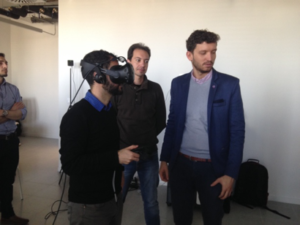A key element of any software development is the architectural design. In the same way the architecture of a building not only defines the look of the finished construction but also the materials, structures and how they all fit together, these things must all be defined for a software framework. This is especially important for … Continue reading “User requirements to Architecture design – The University of Salford”
Category: /NEWS 2018
Subtitles for 360° media – alternative presentation for immersive experiences (part 1)- IRT
When subtitles are provided in a 360° environment, they are typically fixed at the bottom of the screen and centered horizontally. This is fine for common 2D TV, but maybe is not the best strategy for 360° media. By making use of the additional “dimension”, maybe subtitles can convey more than just textual information. Whereas … Continue reading “Subtitles for 360° media – alternative presentation for immersive experiences (part 1)- IRT”

UAB and i2cat test Eye-tracking in 360º – UAB
User centered design approach in ImAc has meant that the user requirements of potential end users such the need to access and engage with immersive content independently are prioritised during the development stages of the project. Real end users are involved in every step of the design and implementation of the tools that will enable … Continue reading “UAB and i2cat test Eye-tracking in 360º – UAB”
Immersive Accessibility Project: Dissemination Plan (Version 1)
As in any project, Dissemination is one of the most dynamic activities in the Immersive Accessibility Project (ImAc) and this document sets out the activities planned as part of it. These activities aim to promote the project and make results available to relevant stakeholders from academia and the industry through the course of this 30-month … Continue reading “Immersive Accessibility Project: Dissemination Plan (Version 1)”
Designing prototypes and developing tools – Anglatècnic
This February, Anglatècnic has begun work on the new technical platform of the ImAc project. Anglatècnic is passionate about research and development in new technologies that are or will end up being disruptive and we believe the ImAc Project presents us with a great opportunity to actively participate in immersive technologies such as 360 and … Continue reading “Designing prototypes and developing tools – Anglatècnic”
ImAc goes to the opera: Romeo and Juliette in 360º – UAB
The Immersive Accessibility Project (ImAc) aims to design tools that will assist with the integration of accessibility features into immersive environments. Four of the nine ImAc partners are based in Barcelona and collaborate with Liceu Opera House on a regular basis. Given the comprehensive social policy embraced at Liceu and the many accessibility services regularly … Continue reading “ImAc goes to the opera: Romeo and Juliette in 360º – UAB”
Motion Spell / GPAC Licensing participates in the Immersive Accessibility (ImAc) project – GPAC Licensing
The GPAC Licensing members have been long time supporters of accessibility initiatives. Magnifier effect while playing a video. GPAC is an open-source project and as such, our aim is to make services and products accessible for the wider community. Our user base includes dozens of thousands of people. This means that both our communication and our software … Continue reading “Motion Spell / GPAC Licensing participates in the Immersive Accessibility (ImAc) project – GPAC Licensing”
Catalan Focus Group for immersive subtitles and sign Language – CCMA
The ImAc project follows a user centric approach and regular feedback is an integral part of the development process in this project. The initial focus groups organised as part of work package 1 aimed to understand the needs of end users in relation to accessibility services in immersive media. This was done in collaboration with … Continue reading “Catalan Focus Group for immersive subtitles and sign Language – CCMA”
